Table of Contents
Because of their varying properties, metals have been an indistinguishable aspect of our lives. From jewellery and cutlery to whole surfaces, there’s plenty for everybody. Metals, on the other side, lose their elegance if they are not adequately cleaned or doing metal cleaning.
We often do metal cleaning only to remove rust. Metal artefacts, on the other side, need a lot of metal cleaning product to clean.
Of course, you can use some of the advanced metal cleaners that can be located on virtually any store’s rack.
However, since all of these metal cleaners are very dangerous, they might not be the right option for all. Dirt2Tidy Cleaner is a true believer in utilizing Eco-friendly homemade detergents to disinfect metals and other surfaces.
You’ll need cleaning tips to do metal cleaning as thoroughly as possible. Cleaning Maintenance experts in the field regarding the best DIY methods for cleaning the numerous types of metals in your house suggests some of the following.
You may like to read: ” DIY Natural Cleaning Products “
There are particular chemicals for washing different metals. Some metal surfaces are more fragile, although others can endure a lot of hard-pressed cleaning. It’s important to realize what sort of metal objects you’ll be cleaning.
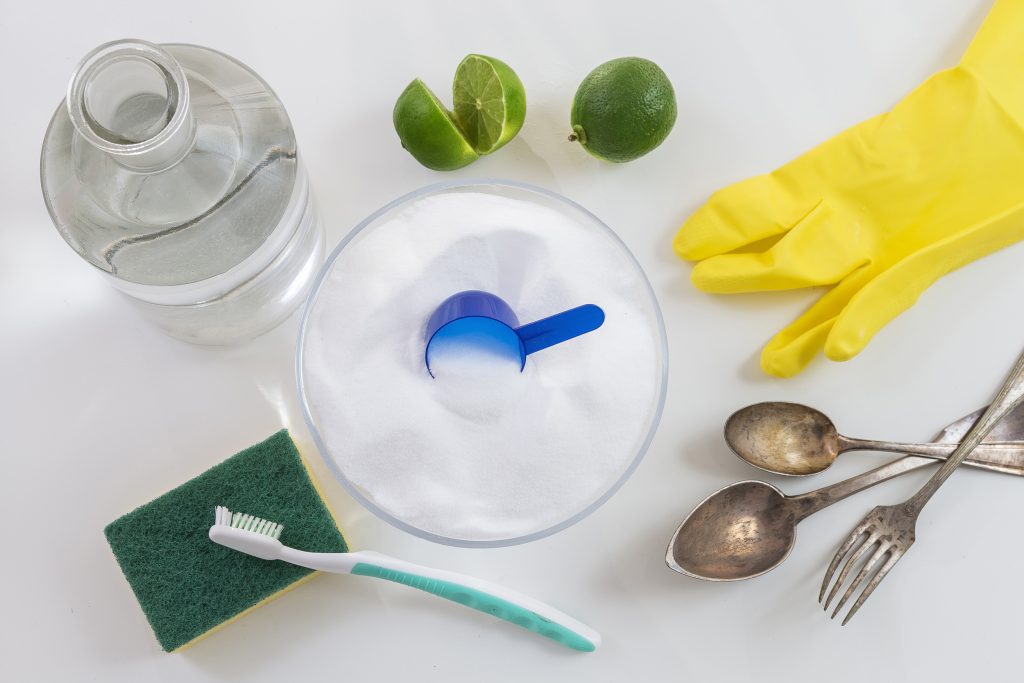
Otherwise, you risk leaving cracks and swirl patterns on the metals such as pots and pans.
Know that if the metal is highly tarnished, you’ll require professional assistance. Sometimes a do-it-yourself project isn’t enough.
How to clean Stainless – Metal Cleaning?
Since stainless steel reveals stains and can quickly become streaky, it is more challenging to keep clean. As a consequence, while washing, it’s important to transfer in one direction and without the grain.
Start tiny and try it out if you’re not sure which way you can go. I like to use a clean microfiber cloth, although you may also use paper towels.

You should also bear in mind that stainless steel comes in a number of ways. You may need to do some testing before deciding what fits well on your particular appliance. For more severe contamination or discoloration, surface treatments like pickling and passivation may be required to restore the metal’s corrosion resistance.
In reality, if you have several stainless-steel appliances, you can need to adopt a slightly different metal cleaning schedule with each one.
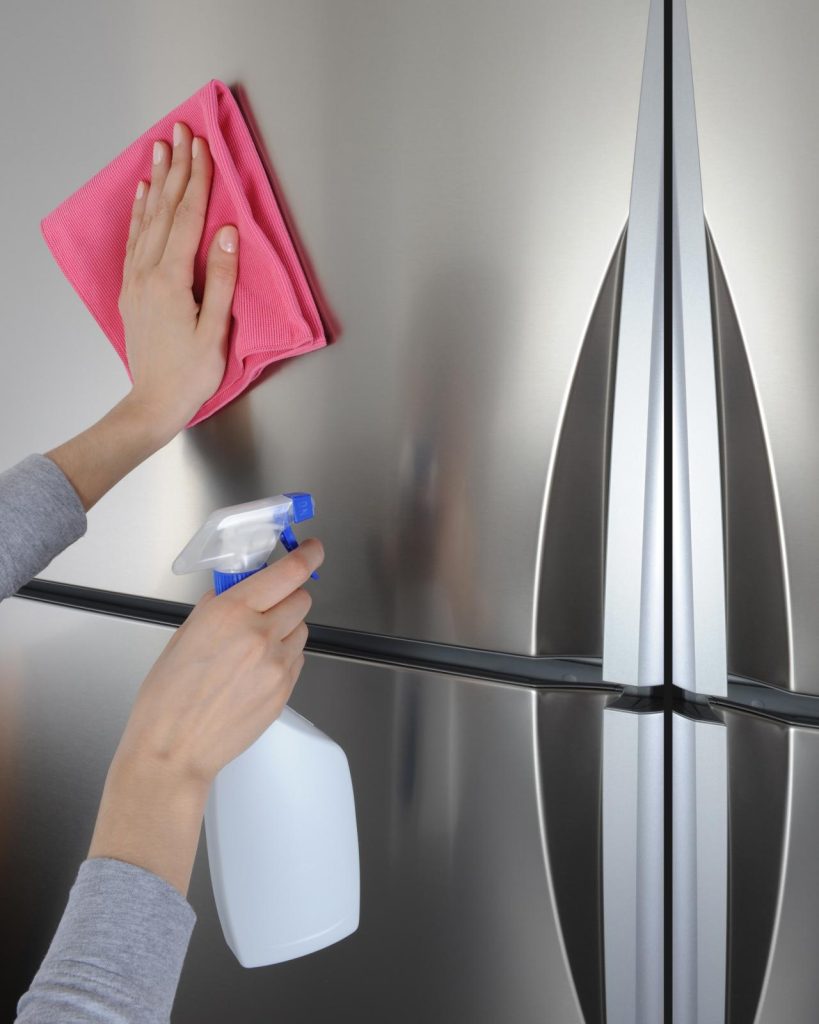
When it comes to washing stainless steel, there are a few big “don’ts”:
• Should not use steel wool, scrubber sheets, or any other abrasive sponges or scrubbers.
• Stop utilizing some chlorine-based cleaners or something including chloride, as well as oven cleaners.
• If the tap water is harsh, it can leave streaks or stains.
Stainless steel can be washed as follows:
Cleaning stainless steel with hot water and a soft clean cotton cloth is the easiest and most economical process. Stainless steel is reasonably easy to keep clean owing to its natural products.
It’s preferable to clean aluminium around the grain.
If plain water isn’t working, consider incorporating a drop of dishwashing liquid into the mix. This would most certainly assist in the dissolution of food leftovers, but if it does not, there is another alternative.
Soak it in soapy water for a couple of minutes before scrubbing it clean with a fluffy sponge. Steel wool can not be used since it will harm the stainless steel’s safe chromium oxide coating.
Alcohol may also be used to remove oil. Rub the greasy areas of rubbing alcohol on a dry soft cloth until they are out. To preserve the metal’s natural shine, always dry it after you’ve finished cleaning it.
Baking soda and water can be used for stubborn stains. Create a paste with it and use it to clean the stain. Bear in mind that, like salt, baking soda may be gritty and abrasive to the eyes.
After that, scrub with clean water to extract any residual baking soda and wipe with a comfortable towel. Wipe away the traces of the items you used with a wet clean cloth as a final touch.
Then rinse the cloth and repeat the operation. Using glass cleaner to provide a gleaming shine.
Read: ” Step by step instructions to Use Baking Soda when Cleaning “
How to clean Chrome?
Chrome gleams when it’s clean no there’s another way to explain it.

Chrome is not very challenging to clean as opposed to other typical household items, including multiple forms of metal. Persistence is more critical than everything else when it comes to maintaining chrome looking its finest.
Water and soap
One of the most successful techniques for cleaning chrome is often one of the most transparent. Apply dish cleaner to a bucket of warm water, and rinse the chrome with a fluffy cloth or nonabrasive sponge dipped in the solution.
Rinse the fabric or sponge regularly when you move along to get rid of the soil that has started to detach and break away from the metal.

Using an old toothbrush to scrub any creases or crevices in the chrome; the bristles will work soapy water through places you wouldn’t be able to access otherwise.
Finish by rinsing the metal with clean water to erase any residue of soap that might have existed on the chrome.
Distilled white vinegar is more effective than dish soap. Mix the vinegar with regular old tap water in a one-to-one ratio, and add the solvent with a fabric or nonabrasive sponge. Clean any hard-to-reach places once more with a toothbrush.

Damage Prevention
There are no harsh chemicals or heavy-duty metal cleaning equipment utilized in the processes mentioned here. Since chrome is a soft metal, this is the case. And a scouring pad will scratch it, but fight the desire to use a raw edge on stubborn stains. Also, if you’re planning to use a supermarket chrome cleaner, make sure the packaging states that it’s good for chrome.
How to get rid of the chrome from life?
The most critical part of cleaning chrome is to keep it from being dusty in the first place. As previously mentioned, chrome is a soft metal that takes more time to clean the dirtier it becomes. As a consequence, the chrome surface is more likely to be affected during the washing process.
Water and dish soap are all that’s required to hold chrome in good condition. Simply fill a sink with water and give your chrome utensils and pots a thorough metal cleaning. It’ll be perfect if you know what we mentioned about greasy water and chrome. Make use of a gentle material.
Using vinegar to get rid of harder stains that water and soap couldn’t manage. It doesn’t matter what kind of vinegar you use as long as it’s transparent. The acid in the vinegar will assist in removing the tarnish. Wipe it with a rag soaked in it.
You may use a sheet of aluminium foil dipped in vinegar to clean rusty spots on your chrome pieces. Scrub carefully so as not to stain the chrome. If the rust spots are serious, fine steel wool may be used, but do it with caution.
When you’re finished, clean it with water and dry it because chrome is vulnerable to water stains. Particularly as compared to brass and copper.
How to clean Aluminum?
An aluminum item that has been lacquered, sprayed, or otherwise coated should be washed according to the coating’s specifications rather than the metal’s. If the aluminum isn’t brushed, obey the cleaning directions for the object or aluminum you’re cleaning.

- You’ll need an acid-based solution to thoroughly clean the piece.
- You should order acidic cleaners that are specially made for the substance you’re cleaning.
Tomatoes, lemons, and even apples may be used to render DIY aluminum cleaning choices at home.

Although acids such as bleach or hydrochloride acid may be used, they have various negative side effects and may not work as well as acids contained in natural ingredients.
The easiest approach to disinfect aluminum is to vigorously wash it. There’s no special trick here. This metal can be washed with only water and dishwashing oil.
Be sure it’s fully safe and clear of oil since this might hinder the next measures.
Place the vessel on the burner and dump water in it if there is burned food at the rim. Get the water to a simmer, and scrub the bottom of the aluminum pot with a wooden spoon until it is clear.
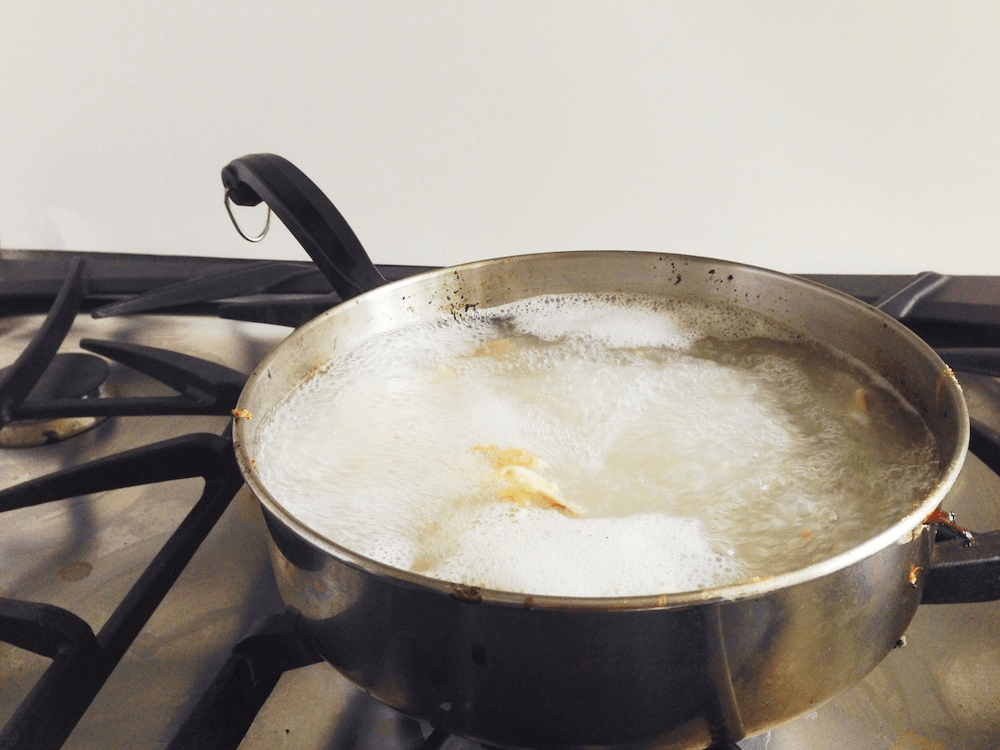
A boiling solution of vinegar, lemon juice, or even simply boiling an acidic fruit like a tomato may be used to clean aluminum pots and pieces. Fill it halfway with water and a tablespoon of vinegar per liter. If it suits, feel free to put something aluminum inside. The oxidation would be removed as a consequence of this.
Steel wool can quickly harm aluminium, which is a very soft product. You may use it as a last resort but bear in mind that you should still operate with the grain of the metal and never use a circular motion, as this would result in swirl marks.
The convenient trick for aluminum surfaces
Break a lemon in half and softly massage the surface with it after dipping it in salt. Bear in mind that the salt grains may be abrasive. If you don’t have a lemon, soak a washcloth in vinegar, sprinkle it with garlic, then go to work on the aluminum!
How to Clean Copper?
Brass, silver, and copper metal pieces bring warmth and charm to every room. They will, though, lose their sparkling look over time and grow a coat of tarnish. Tarnish can’t be avoided except in suitable settings, such as a dry environment away from direct sunshine.
Though tarnish isn’t dangerous in and of itself, it can be unsightly.

When it comes to copper, you’ll want to be extra careful. It’s particularly difficult to clean because scrubbing it so hard will scrape the copper and strip the polish. To safely and efficiently clean and polish.
These metal cleaning treatments for copper astonish anyone who uses them, restoring the natural antique beauty of even the most tarnished copper wares.
Steps for cleaning copper
You must decide if the object you are cleaning is made of copper or is merely copper plated on another metal. This can be achieved using a magnet. If it sticks, the object is actually copper plated.
Since you’ve worked out what sort of substance it is, you’ll need to see if it has a protective layer. A small amount of baking soda into white vinegar and try to clean it. If it brightens right away, there is no defensive layer present.
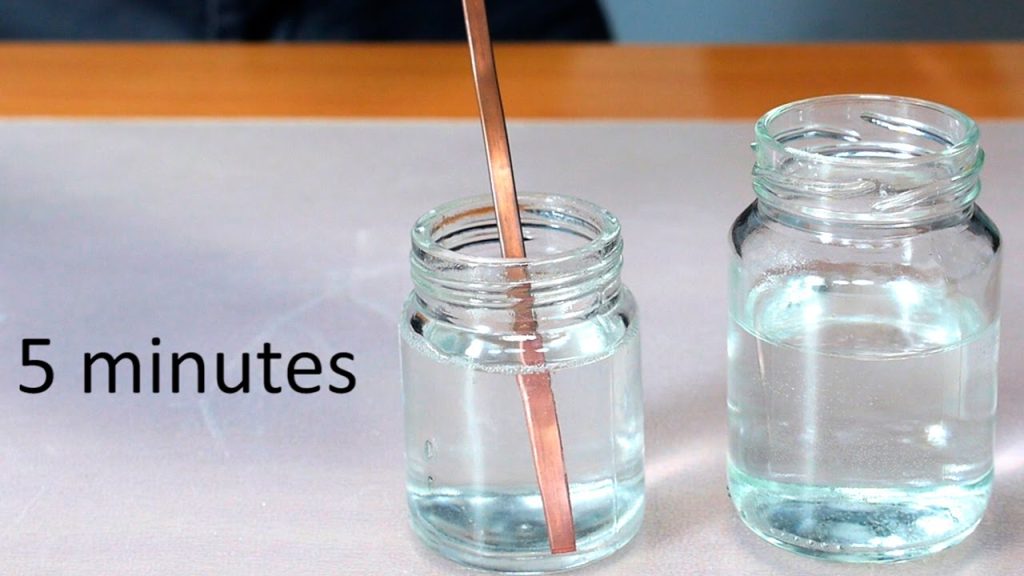
Fill the sink with water and some soft dishwashing liquid for products made entirely of copper that do not have a protective finish. Enable it to soak for 10 minutes before washing it.
This approach isn’t recommended for products that are either copper plated and/or have a lacquer finish. Simply wash it well and a minimal amount of soap and dry it. This is generally appropriate, but if you want absolutely gleaming copper.
Copper polishing paste is simple to make with basic household ingredients. Salt, starch, and white vinegar are used to produce it. To make a smooth paste, add all of the ingredients. You are not expected to follow a precise formula.
Just be careful not to use too much salt, as it will scrape the paint. Apply the paste to the tarnished copper object and leave it to rest for 10 minutes to an hour, depending on how bad it is.
Scrub the paste away with a loose rag, bearing in mind to go with the grain of the copper if possible. You may also do this with a soft-bristled toothbrush. After that, thoroughly clean it with sweat, buff it with a new soft rag, and appreciate the effects as the copper shines. Bear in mind the copper despises water and is quickly stained by it, so make sure it’s fully dry before storing it.
Apply a thin coat of pure olive oil to your copper with a smooth cloth to shield it from stains and patina. It’s less effort than using a store-bought varnish, and the metal’s antimicrobial qualities are maintained.
How to Clean Brass?
As oxygen, water, and other elements cause the metal to corrode or tarnish, your favorite brass parts can lose their luster over time. Fortunately, there are a variety of easy ways to inject new life into your brass. You’ll just need basic household supplies and a few minutes of your time to restore the shine to fixtures, doorknobs, decorative artifacts, and more with our editor-tested techniques on how to clean brass.

However, before you start cleaning brass, double-check that the thing you’re polishing is made of the stuff. Many products are simply brass-plated and can be affected by these metal cleaning techniques. Try our previously advised magnet trick.
Before you start cleaning your brass piece, make sure it hasn’t been lacquered. Lacquer is a thin, lustrous layer that protects against tarnish. Unfortunately, most cleaning techniques can destroy lacquered brass, so taking it to a specialist is your best bet.
You should also know what sort of stain, grime, or buildup you’re dealing with. Often test a metal cleaning procedure in a small, inconspicuous area before applying it to a larger area. You can use several different cleaning techniques on the same spot for sticky stains, just make sure to finish each one before going on to the next.
Consider bringing the brass piece in for a professional cleaning whether you have any questions or if the object you’re trying to clean is important.
You can even wipe brass with ketchup! Simply slather it all on and let it hang for about 10 minutes before washing and polishing thoroughly.

It should come as no surprise that brass despises water just as much as copper, so stop making it wet.
How to clean Silver?
An easy homemade remedy for cleaning tarnished silver and you probably already have all of the ingredients on hand. Cleaning silver with a mixture of aluminum foil, baking soda, and salt works well on both small and big bits.
What You’ll Need
• Baking powder
• Kosher salt
• Fluffy fabric
• Hot water
• Aluminum foil
• Tray or pot
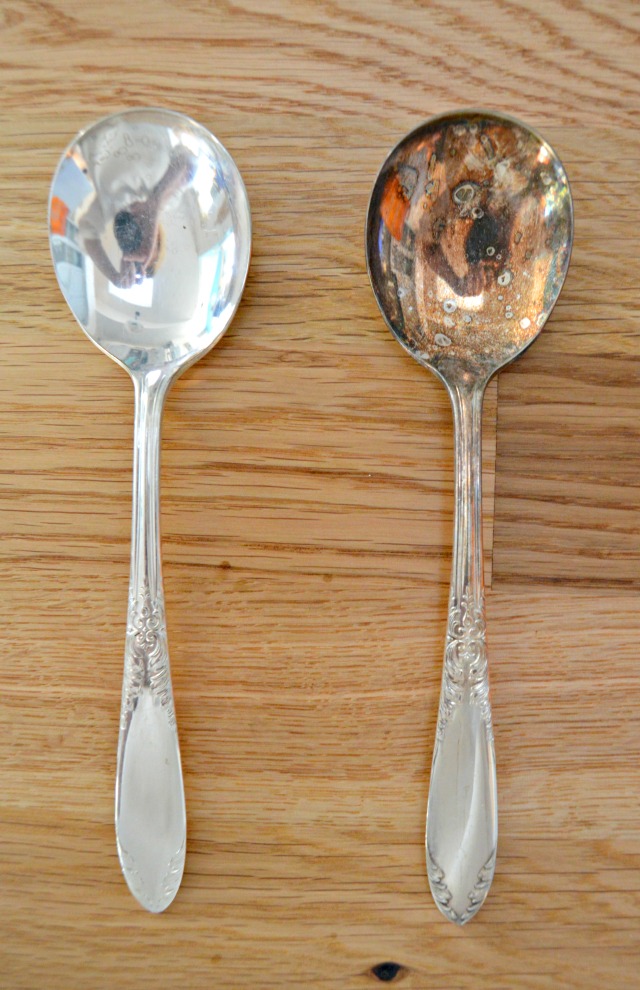
Cleaning Tiny Silver Objects
1. Use aluminum foil to line a pot or roasting pan.
2. Dump hot water into the pan.
3. Whisk together 1/4 cup baking soda and 2 teaspoons of kosher salt in the water.
4. Carefully blend the silver bits into the solution so they don’t ram into edges.
5. Allow for up to 5 minutes of sleeping time.
6. Remove from the oven and dry properly with a soft cloth until it has cooled.
How to Clean Gold?
Yeah, you read it correctly. You don’t have to go to the jeweler any time your gold chains or earrings appear to lose their spark. Using water and soap to clean your gold ornaments is one of the simplest and most effective ways.
Plain gold necklaces, bracelets, earrings, bangles, and other ornaments may be washed with a quick soap and water solution. Cleaning the simple gold jewelry with soap water extracts dirt and oils that have collected over time.
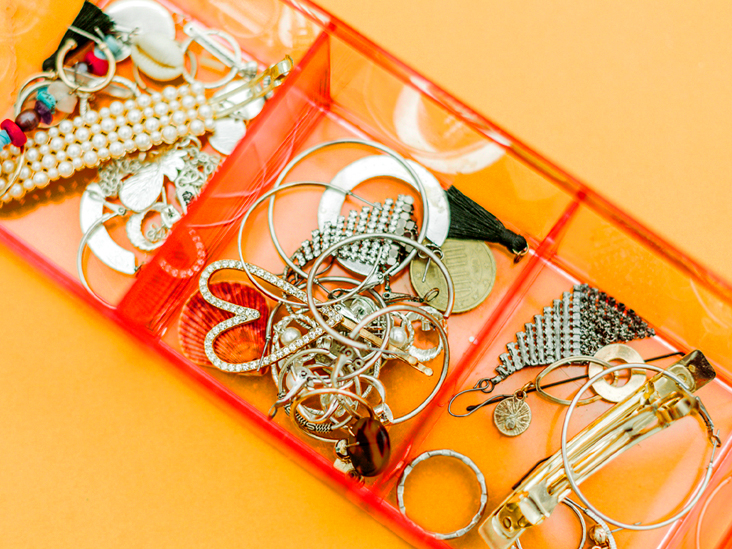
This is one of the simplest and safest ways to regain the luster of your gold jewels.
However, this approach should not be used to clean gemstone-studded jewelry
• To start, fill a bowl halfway with warm water. Add with the soft soap to produce a solution. To make the solution, you can use mild detergents or a few drops of dish-washing oil.
• Using this paste, dip the gold jewels. Enable 15-20 minutes of soak time.
• After that, clean it with cold water and lie it flat on a soft, dry cloth or towel. Enable it to dry entirely in the open air.
• You should even clear dirt from the nooks and crannies with a soft-bristled cleaner. But don’t press the jewels too hard.
• Note to keep it safe and protected, preferably in a jewelry box.
• This soap-water-brush process can be used to clean yellow gold and rose gold jewelry.
Stuff to Remember When Washing Gold Jewelry
• If you want your gold jewelry to last a long time, be extra careful when washing it. Bleach-containing cleaners like solid or liquid can never be used. It has the ability to permanently discolor gold. Pay particular attention to objects that are encrusted with precious stones.
• When washing your gold trinkets, please use a tub. Never wash them in the sink or washbasin with tap water. Make sure the drain is sealed while you’re rinsing the ornaments in the sink.
• When rinsing the gemstone gold jewelry, do not use a heavy stream of water from the faucet.
Your simple gold and gemstone studded pieces will maintain their natural sheen with gentle cleaning. If you’re confused, head to a trustworthy jeweler.




